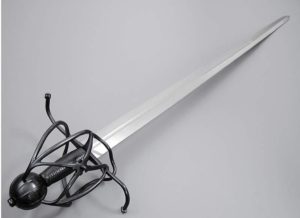by John Sadler
 One of the most notable historians of Anglo-Scottish Border conflicts, John Sadler has published a number of books on the subject and is also a successful lecturer, heritage consultant, historical interpreter and battlefield tour guide. ‘From an early age I have been obsessed with the highlands and borders.’ he says, ‘Since then I have travelled, walked, ridden and driven over most of the ground and looked at every battlefield, hillfort, broch, dun and castle.’
One of the most notable historians of Anglo-Scottish Border conflicts, John Sadler has published a number of books on the subject and is also a successful lecturer, heritage consultant, historical interpreter and battlefield tour guide. ‘From an early age I have been obsessed with the highlands and borders.’ he says, ‘Since then I have travelled, walked, ridden and driven over most of the ground and looked at every battlefield, hillfort, broch, dun and castle.’
Sadler regularly lectures at The National Army Museum, Imperial war Museum, RMA Sandhurst, Heriot Watt University, Society of Antiquaries of Newcastle upon Tyne, The Literary and Philosophical Society, Newcastle, Durham University, the DLI Museum & Art Gallery and contributes to many military and historical journals as well. He is a Fellow of the Royal Historical Society, a Fellow of Scotland’s Society of Antiquaries, a graduate Holocaust Fellow of the Imperial War Museum and a member of Equity.
STEEL BONNETS
Episode 2
Peles and Bastles
By the middle of the 16 th Century life in the south of England was becoming relatively safe and prosperous the Borders were fastened in the bitter grip of strife.
 Families in the area began to replace their old steadings, made of timber and earth, with relatively strong buildings made of stone; indeed, the availability of local material was one reason for bastles being built. On the whole it was fairly well-off tenants who undertook this work rather than landlords – after all, it was their families and cattle that were under threat.
Families in the area began to replace their old steadings, made of timber and earth, with relatively strong buildings made of stone; indeed, the availability of local material was one reason for bastles being built. On the whole it was fairly well-off tenants who undertook this work rather than landlords – after all, it was their families and cattle that were under threat.
These new, defensible farmhouses were known as bastles, presumably from the French bâtir to build, as in bastille, a fortified building. As explained, the unruly and anarchic society in the Borders meant that the unification of the Crown in 1603 did not completely vitiate the need for bastles, which continued to be built for many years. Roughly speaking, most were built between 1550 and 1650, although many bear a later date which is the date of renovation rather than that of the original construction.
George MacDonald Fraser memorably described grim Hermitage Castle in Liddesdale as Sod off in stone. Just about right, and bastles represent a poorer man’s version; locals probably expressed the sentiment even more pithily.
They were not isolated structures. Many had outbuildings, the remains of which can often be seen, (as at Black Middens in Tarset), and they were often built in sight of other bastles – indeed they are often found in small groups. This would facilitate an alarm being raised and would enable those being attacked to receive succour from neighbours. Evistones town-ship, near Otterburn, is a superb example of a community of bastles. Some were extended, a second building being built onto the end of a first, at the ‘byre door end’, forming a larger whole. In other cases, they were built in terraces, as seems to have been the case at Wall village, where individual bastles kept their integrity although they were linked to their neighbours, presumably these were ‘link’ as opposed to ‘executive’ bunkers.
 I’ve had days of fun defending a bastle against Scottish riders; easy to re-enact since you only need a handful of players on each side and of course, plenty of scope for the women to join in heartily. Accounts not infrequently mention female participants, fighting and dying to protect hearth and home. So many towers survive intact or virtually intact as well, you’re practically spoiled for choice besides, with even a modicum of imagination, you can transform a simple stone barn into a wannabe bastle house. Essentially the place is a bunker, merely a more picturesque version of what you’d see on the Western Front. Had our ancestors possessed pre-cast reinforced concrete, that’s what they’d have used. They built with an eye on expediency rather than heritage tourism.
I’ve had days of fun defending a bastle against Scottish riders; easy to re-enact since you only need a handful of players on each side and of course, plenty of scope for the women to join in heartily. Accounts not infrequently mention female participants, fighting and dying to protect hearth and home. So many towers survive intact or virtually intact as well, you’re practically spoiled for choice besides, with even a modicum of imagination, you can transform a simple stone barn into a wannabe bastle house. Essentially the place is a bunker, merely a more picturesque version of what you’d see on the Western Front. Had our ancestors possessed pre-cast reinforced concrete, that’s what they’d have used. They built with an eye on expediency rather than heritage tourism.
This may be a good place to point out that some bastles are known as peles or peels – Thropton Peel is an example. The words are often used synonymously, but the etymology of peel is from the French pel, meaning wooden stake. Bastles were defensible farmhouses; as such they are neither glamorous nor pretentious. Stark, rough hewn, they stand as firm as if they had sprung organically from the harsh upland itself. Utilitarian and austere, their allure (if they can claim such) arising from perceived romance and durability.
On the ground floor was the byre, into which cattle were driven when a raid was imminent or during particularly bad weather. Without drainage or stalls, it seems unlikely that this space was to be utilised for lengthy periods. Above lay the family’s Spartan living quarters, devoid of comfort other than a fireplace set into one gable, (usually at the opposite end to the doorway). Rarely bigger than 12m x 8m, bastles are rectangular in shape and typically have walls between 0.7m and 1.4m thick.

Constructed of large, irregular stone blocks; gaps between the blocks were packed with smaller stones set in mortar. They have steeply pitched gables and many were probably roofed initially with heather thatching.
What we lack is a Samuel Pepys, or Mrs. Pepys of the border. We hear about the reivers rather than from them. How the good wife felt about her husband’s nocturnal enterprise is generally unrecorded.
Domestic life, of course did go on, people married often in defiance of the cross border prohibition, raised children and focused on the daily business of survival.
In the midst of the mayhem are the women: sitting quietly at home … Well, not really.
The women of Redesdale are as notorious as their men, riding out in their own right when necessary. Those remaining in their bastles can act in defence of home and property, using gun, bow or knife to fend off intruders. Or sending out the raiders themselves; a famous painting of the C19th shows a good wife presenting a pair of spurs on an empty platter: Fetch the supper in.
This is a militarized society but it also an agricultural one. Women work hard, tending animals, growing what vegetables and grain will thrive on land as poor as this and collecting whatever food is available. Wild herbs and greens collected in the spring provide much-needed vitamins during the hungry gap before the garden crops come through.
Later in the year, meat, poultry and fish traded in from the coast or plundered from the rivers need to be preserved ready for winter.
Grain – oats and barley mostly, for this is not wheat growing territory, will be ground into bread-flour. In times of greatest need all will eat the horse bread which takes its name from the cereals fed to animals: dried peas, oats and barley used to make a loaf of high density and legendary keeping qualities.
These same grains are the basis of that other staple, pottage. This is a thick soup/stew which simmers away on the back of the fire turning anything available into a savoury main dish eaten by all. Meat if you have any, grains and pulses, vegetables and herbs: in they all go. By March it is mostly water, leftover barley and dried nettles. Unless the idle man of the house has managed to acquire a sheep or two.
Mutton broth – the smell alone will fill a hungry stomach.
All of this is the grand fare for living history, gripping both young and old in their different ways.
Parents applaud the healthy eating programme, recommending wholemeal bread, unprocessed grains and the drive for any vegetable you can get. Their offspring recoil in disgust from the dense loaf (it makes a very satisfying crunch when you bang it against the board to demonstrate solidity) whilst poking enquiring fingers into dried herbs and grains.
Best of all, set them grinding whilst they are still young enough to view the activity as entertainment rather than child labour.
I recall, in full it as ever attempting to present potage as Britain’s best Dish to some sneering lout of a master-chef type. He thought I was a competitor, I thought we were comic relief amongst the eager gaggle of earnest wannabes, might have been fun if we hadn’t detested each other on sight. I really hate egotists; anyone with an ego greater than mine has a real problem.


